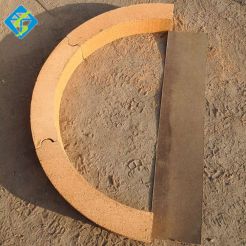applications of refractory bricks
Product Description
Refractory bricks come in various compositions and shapes, each designed to meet specific requirements in different applications. Here are some common compositions and their corresponding applications:
1. Fireclay Bricks: Fireclay bricks are made from clay containing a high percentage of alumina. They have good thermal insulation properties and are used in applications such as fireplaces, chimneys, and residential furnaces.
2. Silica Bricks: Silica bricks are primarily composed of silica, which offers excellent resistance to high temperatures and thermal shock. They are commonly used in coke ovens, glass furnaces, and other environments where high-temperature stability is required.
3. Magnesia Bricks: Magnesia bricks are made from magnesite (magnesium carbonate) or fused magnesia. They exhibit high refractoriness and resistance to basic slags and are used in steelmaking applications, cement kilns, and non-ferrous metal furnaces.
4. Chrome Bricks: Chrome bricks contain chromium oxide, which imparts excellent corrosion resistance and high-temperature performance. They are used in applications like copper smelting, chemical industry furnaces, and other environments where resistance to corrosive materials is crucial.
5. Carbon Bricks: Carbon bricks are made from carbonaceous materials, typically graphite or carbon black. They have exceptional thermal conductivity and resistance to chemical attack, making them suitable for use in blast furnaces, electric arc furnaces, and other high-temperature environments involving molten metal.
In addition to different compositions, refractory bricks also come in various shapes and sizes to accommodate specific applications:
1. Standard Bricks: Rectangular-shaped bricks used for general lining purposes in furnaces, kilns, and other heat-intensive equipment.
2. Insulating Bricks: Lightweight and porous bricks designed for thermal insulation to minimize heat loss. They are commonly used in applications that require energy efficiency, such as kiln linings and thermal insulation layers.
3. Special Shapes: Refractory bricks can be manufactured in custom shapes to fit specific installations, such as curved bricks for furnace crowns, arches, or other intricate designs.
4. Monolithic Refractories: While not technically bricks, monolithic refractories are refractory materials that can be poured or sprayed in place to form linings. They offer flexibility in design and are used in applications such as ladle linings, boiler linings, and other complex shapes.
The selection of refractory brick compositions and shapes depends on factors such as temperature requirements, chemical resistance, thermal insulation needs, and specific operational conditions of the application.
For domestic uses, such as ovens, grills and fireplaces, the refractory bricks used are usually composed of clay containing mainly alumina and silica, elements that can withstand high temperatures. While alumina has reflective properties, silica is an excellent insulator. The more alumina in the mixture, the higher the temperature the brick can withstand (an important consideration for industrial use) and the more expensive the brick will be. Silicon dioxide has a lighter gray hue, while aluminum oxide has a lighter yellow appearance.
For more information, please visit our website.




